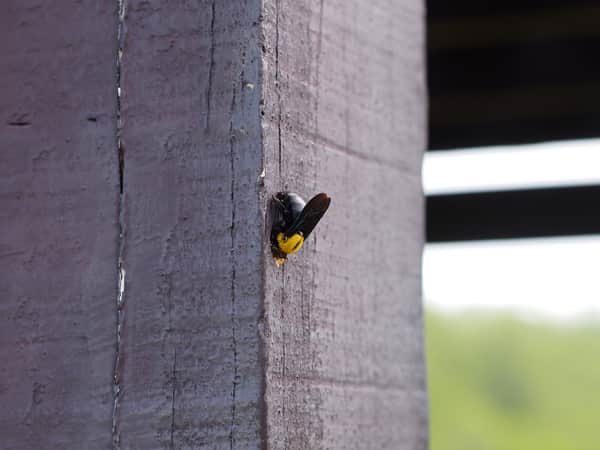Have you seen what looks like bumble bees buzzing around the eaves or wood of your home? This sight can be a real puzzler, especially if you can’t seem to figure out where their hive is. Well, you can stop scratching your head now; there’s a good chance you’re dealing with carpenter bees.

Do carpenter bees sting? And why are they hanging out around your house? Read on to find the answer to these queries and some other carpenter bee FAQS.
What Are Carpenter Bees?
Many people call carpenter bees “wood bees,” and with good reason. These insects like to burrow and nest in wood. You’ll usually know if you have carpenter bees because you’ll likely see them flying around wooden areas of your home or in and out of wood piles or sheds. The entrance to their burrows are perfectly round holes that are just about the size of a finger. (Don’t stick your finger into these holes.) Additionally, carpenter bees may leave piles of sawdust behind as they carve out their tunnels.
What Do Carpenter Bees Look Like?
A lot of people confuse carpenter bees with bumble bees because they’re about the same size and can also be similar in color. As far as appearance goes, carpenter bees are usually around 1 inch in length and can be solid black or black and yellow. However, unlike a bumble bee, which is fuzzy all over, carpenter bees have hairless, shiny black abdomens.
Do Carpenter Bees Eat Wood?
One common misconception is that carpenter bees eat wood. This assumption makes sense as they do live and bore in wood and many insects that do this, like termites, do feed on cellulose. However, carpenter bees eat nectar, while their larvae are fed a special "bee bread" that is made and stored in the wooden burrows.
Are Carpenter Bees Pollinators?
Like honey bees and bumble bees, carpenter bees do play a role in pollination. But there’s another reason that carpenter bees help pollinate flowers and crops. The bee bread the larvae are fed is made from a combination of pollen and regurgitated nectar. Carpenter bees are actually considered a key pollinator because they gather pollen and nectar for their larvae, in turn cross pollinating other plants.
Do Carpenter Bees Sting?
The short answer is yes. Female carpenter bees can sting you, although they are very unlikely to do so unless you’re handling them or poking your fingers into their burrows (which is already mentioned above as something you should not do). Male carpenter bees are not equipped with stingers. However, they do hover outside the burrow exit and guard the nest. If you get too close, the male may buzz and fly at you aggressively. Because these bees are fairly large, this is usually enough to drive people away.
How Can I Try to Control Carpenter Bees?
As pollinators, carpenter bees are very beneficial to the environment, so it’s always best to leave them alone if you can. There are a few steps you can take to help prevent carpenter bees:
- Paint or stain the surface of the exposed wood on your home. (Painting is better.) Carpenter bees prefer untreated wood. Note: It’s a good idea to treat your wood with a paint or varnish that creates a slick surface that carpenter bees have trouble latching onto.
- Keep garage doors and other openings shut during the spring, which is nesting season.
- Eliminate attractants close to your home by covering sugary drinks and fruits when you’re outdoors and keeping trash cans sealed and away from the house.



